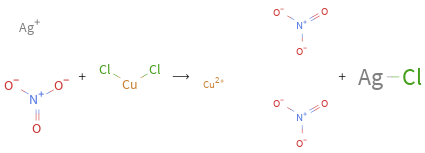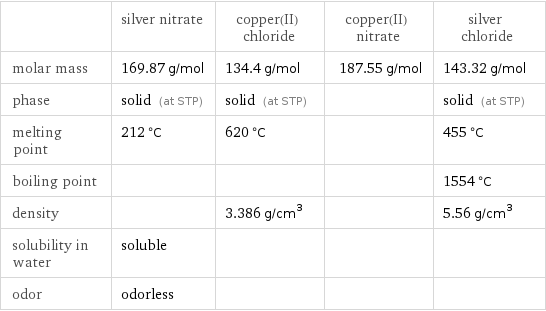Input interpretation

silver nitrate + copper(II) chloride ⟶ copper(II) nitrate + silver chloride
Balanced equation

Balance the chemical equation algebraically: + ⟶ + Add stoichiometric coefficients, c_i, to the reactants and products: c_1 + c_2 ⟶ c_3 + c_4 Set the number of atoms in the reactants equal to the number of atoms in the products for Ag, N, O, Cl and Cu: Ag: | c_1 = c_4 N: | c_1 = 2 c_3 O: | 3 c_1 = 6 c_3 Cl: | 2 c_2 = c_4 Cu: | c_2 = c_3 Since the coefficients are relative quantities and underdetermined, choose a coefficient to set arbitrarily. To keep the coefficients small, the arbitrary value is ordinarily one. For instance, set c_2 = 1 and solve the system of equations for the remaining coefficients: c_1 = 2 c_2 = 1 c_3 = 1 c_4 = 2 Substitute the coefficients into the chemical reaction to obtain the balanced equation: Answer: | | 2 + ⟶ + 2
Structures

+ ⟶ +
Names

silver nitrate + copper(II) chloride ⟶ copper(II) nitrate + silver chloride
Chemical names and formulas

| silver nitrate | copper(II) chloride | copper(II) nitrate | silver chloride Hill formula | AgNO_3 | Cl_2Cu | CuN_2O_6 | AgCl name | silver nitrate | copper(II) chloride | copper(II) nitrate | silver chloride IUPAC name | silver nitrate | dichlorocopper | copper(II) nitrate | chlorosilver
Substance properties

| silver nitrate | copper(II) chloride | copper(II) nitrate | silver chloride molar mass | 169.87 g/mol | 134.4 g/mol | 187.55 g/mol | 143.32 g/mol phase | solid (at STP) | solid (at STP) | | solid (at STP) melting point | 212 °C | 620 °C | | 455 °C boiling point | | | | 1554 °C density | | 3.386 g/cm^3 | | 5.56 g/cm^3 solubility in water | soluble | | | odor | odorless | | |
Units
